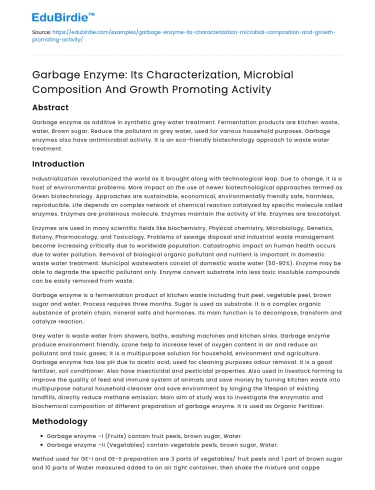Abstract
Garbage enzyme as additive in synthetic grey water treatment. Fermentation products are kitchen waste, water, Brown sugar. Reduce the pollutant in grey water, used for various household purposes. Garbage enzymes also have antimicrobial activity. It is an eco-friendly biotechnology approach to waste water treatment.
Introduction
Industrialization revolutionized the world as it brought along with technological leap. Due to change, it is a host of environmental problems. More impact on the use of newer biotechnological approaches termed as Green biotechnology. Approaches are sustainable, economical, environmentally friendly safe, harmless, reproducible. Life depends on complex network of chemical reaction catalyzed by specific molecule called enzymes. Enzymes are proteinous molecule. Enzymes maintain the activity of life. Enzymes are biocatalyst.
Save your time!
We can take care of your essay
- Proper editing and formatting
- Free revision, title page, and bibliography
- Flexible prices and money-back guarantee
Enzymes are used in many scientific fields like biochemistry, Physical chemistry, Microbiology, Genetics, Botany, Pharmacology, and Toxicology. Problems of sewage disposal and industrial waste management become increasing critically due to worldwide population. Catastrophic impact on human health occurs due to water pollution. Removal of biological organic pollutant and nutrient is important in domestic waste water treatment. Municipal wastewaters consist of domestic waste water (50-90%). Enzyme may be able to degrade the specific pollutant only. Enzyme convert substrate into less toxic insoluble compounds can be easily removed from waste.
Garbage enzyme is a fermentation product of kitchen waste including fruit peel, vegetable peel, brown sugar and water. Process requires three months. Sugar is used as substrate. It is a complex organic substance of protein chain, mineral salts and hormones. Its main function is to decompose, transform and catalyze reaction.
Grey water is waste water from showers, baths, washing machines and kitchen sinks. Garbage enzyme produce environment friendly, ozone help to increase level of oxygen content in air and reduce air pollutant and toxic gases; it is a multipurpose solution for household, environment and agriculture. Garbage enzyme has low pH due to acetic acid, used for cleaning purposes odour removal. It is a good fertilizer, soil conditioner. Also have insecticidal and pesticidal properties. Also used in livestock farming to improve the quality of feed and immune system of animals and save money by turning kitchen waste into multipurpose natural household cleanser and save environment by longing the lifespan of existing landfills, directly reduce methane emission. Main aim of study was to investigate the enzymatic and biochemical composition of different preparation of garbage enzyme. It is used as Organic Fertilizer.
Methodology
- Garbage enzyme –I (Fruits) contain fruit peels, brown sugar, Water.
- Garbage enzyme –II (Vegetables) contain vegetable peels, brown sugar, Water.
Method used for GE-I and GE-II preparation are 3 parts of vegetables/ fruit peels and 1 part of brown sugar and 10 parts of Water measured added to an air tight container, then shake the mixture and capped the bottle tightly. For fermentation process, space was left in container, then closed it tightly and leaves it for 3 months. During the first month of fermentation, gases were released once a day, then container was placed in cool dry, well ventilated area to avoid direct sunlight. After 3 months of fermentation process, color of GE was dark brown.
Biochemical characterizations of garbage enzyme are: Estimation of Protein by Biuret method, Carbohydrate by Anthrone method, Acetic acid estimation, Estimation of Alcohol
Test for microbial composition
Nutrient agar was prepared, Amphotericin B is added as an antifungal agent and pH was adjusted to 7.2-7.4 by using 1N HCl and 1N NaOH. The media was autoclaved and poured in Petri plates under aseptic conditions. 100µl of GE was spread on agar plate. The plates were incubated at 37°C for 24hrs to check the growth. Gram positive and gram negative bacteria were identified by using Gram staining.
Fungal composition: YEPD agar was prepared, Ampicillin is added as an antibacterial agent and pH was adjusted to 6.3 by using 1N HCl or 1N NaOH. The media was autoclaved and kept overnight at 37°C to check for contamination. Media was poured in Petri plate. 100µl of GE was spread on agar plate. Incubate the plates at 27°C for 24-48 hrs to check the growth. Fungal strains were identified using Lactophenol Cotton Blue Stain.
Microbial composition
Microbial composition of GE was examined by spread plate method and then colonies were stained by Gram stain and Lactophenol Cotton Blue. By microscopic examination of growth, the presence of gram negative rod shaped bacteria was found. These results indicate the presence of heterogeneous bacterial population in the GE preparation.
Summary and Conclusion
The present study was carried out to study the effect of GE. Complete characterization as regard its physical, biochemical, enzymatic, microbial composition and plant growth promoting ability was done. Seed germination parameter indicated the significant effect of GE on germination. This result provides an evidence for the proposed applications of garbage enzyme as fertilizer and plant growth enhancers. GE preparation at room temperature supported heterogeneous population of microorganisms. Garbage enzyme as an additive in waste water treatment, which offers an eco-friendly biotechnological approach to waste water management
Refrences
- Cheng L.L. Garbage Enzyme in container (www.ecowalkhe talk.com)
- Garbage enzyme- multipurpose uses and safer and cleaner alternative (www.instructable.com)
- Parkash B (2011) Response: How effective are garbage enzyme.






 Stuck on your essay?
Stuck on your essay?

